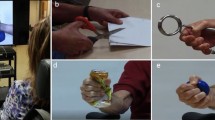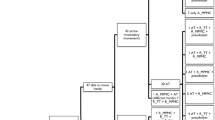Abstract
Research on isometric contractions in subjects with Parkinson’s disease (PD) has shown that anti-parkinsonian medication results in a greater increase in extensor strength than flexor strength. This finding is consistent with the hypothesis that there is a greater impairment in neural activation of extensor muscles as compared to flexor muscles in subjects with PD. Such a hypothesis is physiologically feasible given the known differences in the neural control of flexor and extensor muscles. If the above hypothesis is true for both phasic and tonic muscle activation, then differences between performance of rapid single-joint flexion and extension movements should exist in subjects with PD. Twelve subjects with PD, “off” and “on” medication, and 12 age- and sex-matched healthy control subjects performed rapid single-joint movements in flexion and extension over three distances. For neurologically healthy subjects, we did not identify any significant differences in either kinematic or EMG parameters between flexion and extension movements. In contrast, in the PD subjects extension movements were slower and associated with more agonist bursts when compared to flexion movements. The results are consistent with the hypothesis that there is a differential impairment of neural activation of extensor muscles of the arm as compared to flexor muscles in subjects with PD.






Similar content being viewed by others
References
Agostino R, Curra A, Giovannelli M, Modugno N, Manfredi M, Berardelli A (2003) Impairment of individual finger movements in Parkinson’s disease. Mov Disord 18:560–592
Askew LJ, An KN, Morrey BF, Chao EY (1987) Isometric elbow strength in normal individuals. Clin Orthop 261–266
Berardelli A, Dick JP, Rothwell JC, Day BL, Marsden CD (1986) Scaling of the size of the first agonist EMG burst during rapid wrist movements in patients with Parkinson’s disease. J Neurol Neurosurg Psychiatry 49:1273–1279
Berardelli A, Hallett M, Rothwell JC, Agostino R, Manfredi M, Thompson PD, Marsden CD (1996) Single-joint rapid arm movements in normal subjects and in patients with motor disorders. Brain 119:661–674
Berardelli A, Rothwell JC, Thompson PD, Hallett M (2001) Pathophysiology of bradykinesia in Parkinson’s disease. Brain 124:2131–2146
Bobath B (1978) Adult hemiplegia: evaluation and treatment. William Heinemann Medical Books, London
Brown P, Corcos DM, Rothwell JC (1997) Does parkinsonian action tremor contribute to muscle weakness in Parkinson’s disease? Brain 120:401–408
Buchman AS, Leurgans S, Gottlieb GL, Chen CH, Almeida GL, Corcos DM (2000) Effect of age and gender in the control of elbow flexion movements. J Mot Behav 32:391–399
Carr JH, Shepherd RB (1998) Neurological rehabilitation. Butterworth & Heinemann, Boston
Clark DH (1960) Correlation between the strength/mass ratio and the speed of an arm movement. Res Q 31:570–574
Cooke JD, Brown SH (1990) Movement-related phasic muscle activation. II. Generation and functional role of the triphasic pattern. J Neurophysiol 63:465–472
Corcos DM, Chen CM, Quinn NP, McAuley J, Rothwell JC (1996) Strength in Parkinson’s disease: relationship to rate of force generation and clinical status. Ann Neurol 39:79–88
Dietz V, Colombo G (1998) Influence of body load on the gait pattern in Parkinson’s disease. Mov Disord 13:255–261
Enoka RM (1994) Neuromechanical basis of kinesiology. Human Kinetics, Champaign, IL
Fahn S, Elton RL, members of the UPDRS Development Committee (1987) Unified Parkinson’s disease rating scale. In: Fahn S, Marsden CD, Calne DB, Goldstein M (eds) Recent developments in Parkinson’s disease, vol 2. MacMillan Health Care Information, New Jersey, pp 153–163
Fujita M, Nakamura R (1988) Choice reaction time of elbow flexion and extension during passive elbow motions. Percept Mot Skills 67:905–906
Gottlieb GL, Corcos DM, Agarwal GC (1989a) Organizing principles for single-joint movements. I. A speed-insensitive strategy. J Neurophysiol 62:342–357
Gottlieb GL, Corcos DM, Agarwal GC (1989b) Strategies for the control of voluntary movements with one mechanical degree of freedom. Behav Brain Sci 12:189–210
Gracies JM, Weisz DJ, Yang BY, Flanagan S, Simpson D (2002) Spastic cocontraction and movement speed: effects of botulinum toxin type A injection into an agonist. Ann Neurol 52:S89–S89
Hallett M, Khoshbin S (1980) A physiological mechanism of bradykinesia. Brain 103:301–314
Haslinger B, Erhard P, Kampfe N, Boecker H, Rummeny E, Schwaiger M, Conrad B, Ceballos-Baumann AO (2001) Event-related functional magnetic resonance imaging in Parkinson’s disease before and after levodopa. Brain 124:558–570
Henry FM, Whitley JD (1960) Relationships between individual differences in strength, speed, and mass in an arm movement. Res Q 31:24–33
Hoehn MM, Yahr MD (1967) Parkinsonism: onset, progression, and mortality. Neurology 17:427–444
Hore J, Vilis T (1980) Arm movement performance during reversible basal ganglia lesions in the monkey. Exp Brain Res 39:217–228
Ilic DB, Mirkov D, Jaric S (1998) Learning transfer from flexion to extension movements: importance of the final position. Motor Control 2:221–227
Imai T, Yamamoto T, Ohkubo Y, Kashiwagi M, Chiba S, Matsumoto H (1999) Reciprocal facilitation of motor evoked potentials immediately before voluntary movements in Parkinson’s disease. Electromyogr Clin Neurophysiol 39:201–206
Jaric S, Ropret R, Kukolj M, Ilic DB (1995) Role of agonist and antagonist muscle strength in performance of rapid movements. Eur J Appl Physiol 71:464–468
Jordan N, Sagar HJ, Cooper JA (1992) A component analysis of the generation and release of isometric force in Parkinson’s disease. J Neurol Neurosurg Psychiatry 55:572–576
Karst GM, Hasan Z (1987) Antagonist muscle activity during human forearm movements under varying kinematic and loading conditions. Exp Brain Res 67:391–401
Lieberman JS (1986) Hemiplegia: rehabilitation of upper extremity. In: Kaplan PE, Cerullo LJ (eds) Stroke rehabilitation. Butterworths, Boston, pp 95–117
Little JW, Massagli TL (1993) Spasticity and associated abnormalities of muscle tone. In: DeLisa JA (ed) Rehabilitation medicine: principles and practice. JB Lippincott, Philadelphia, pp 666–680
Logigian E, Hefter H, Reiners K, Freund HJ (1991) Does tremor pace repetitive voluntary motor behavior in Parkinson’s disease? Ann Neurol 30:172–179
Murray WM, Buchanan TS, Delp SL (2000) The isometric functional capacity of muscles that cross the elbow. J Biomech 33:943–952
Nelson RC, Fahrney RA (1965) Relationship between strength and speed of elbow flexion. Res Q 36:455–463
Nogaki H, Kakinuma S, Morimatsu M (2001) Muscle weakness in Parkinson’s disease: a follow-up study. Parkinsonism Related Disord 8:57–62
Palmer E, Ashby P (1992) Corticospinal projections to upper limb motoneurones in humans. J Physiol 448:397–412
Pedersen SW, Oberg B (1993) Dynamic strength in Parkinson’s disease. Quantitative measurements following withdrawal of medication. Eur Neurol 33:97–102
Pfann KD, Hoffman DS, Gottlieb GL, Strick PL, Corcos DM (1998) Common principles underlying the control of rapid, single degree-of-freedom movements at different joints. Exp Brain Res 118:35–51
Pfann KD, Buchman AS, Comella CL, Corcos DM (2001) Control of movement distance in Parkinson’s disease. Mov Disord 16:1048–1065
Rasch PJ (1954) Relationship of arm strength, weight, and length to speed of arm movement. Res Q 25:328–332
Robichaud JA, Pfann KD, Comella CL, Corcos DM (2002) Effect of medication on EMG patterns in individuals with Parkinson’s disease. Mov Disord 17:950–960
Stelmach GE, Worringham CJ (1988) The preparation and production of isometric force in Parkinson’s disease. Neuropsychologia 26:93–103
Stelmach GE, Teasdale N, Phillips J, Worringham CJ (1989) Force production characteristics in Parkinson’s disease. Exp Brain Res 76:165–172
Sternad D, Corcos DM (2001) Effect of task and instruction on patterns of muscle activation: Wachholder and beyond. Motor Control 5:307–336
Wachholder K, Altenburger H (1926) Beiträge zur Physiologie der willkürlichen Bewegung. X. Mitteilung. Einzelbewegungen. Pflugers Arch 214:642–661
Wierzbicka MM, Wiegner AW (1992) Effects of weak antagonist on fast elbow flexion movements in man. Exp Brain Res 91:509–519
Winter DA (1990) Biomechanics and motor control of human movement. John Wiley, New York
Yue GH, Liu JZ, Siemionow V, Ranganathan VK, Ng TC, Sahgal V (2000) Brain activation during human finger extension and flexion movements. Brain Res 856:291–300
Acknowledgements.
This study was supported in part by the National Institute of Arthritis and Musculoskeletal and Skin Diseases (RO1-AR 33189), the National Institute of Neurological and Communicative Disorders and Stroke (RO1-NS 28127 and RO1-NS 40902), and by the National Institute on Disability and Rehabilitation Research (H133P000005).
Author information
Authors and Affiliations
Corresponding author
Rights and permissions
About this article
Cite this article
Robichaud, J.A., Pfann, K.D., Comella, C.L. et al. Greater impairment of extension movements as compared to flexion movements in Parkinson’s disease. Exp Brain Res 156, 240–254 (2004). https://doi.org/10.1007/s00221-003-1782-0
Received:
Accepted:
Published:
Issue Date:
DOI: https://doi.org/10.1007/s00221-003-1782-0




